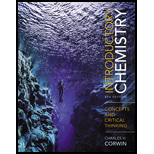
Concept explainers
(a)
Interpretation:
The given Celsius temperature is to be expressed in degrees Fahrenheit.
Concept introduction:
Temperature can be measured in Kelvin scale, Celsius scale and Fahrenheit scale. Celsius is commonly used measurement unit for temperature. The relation between Celsius and Fahrenheit is,
(b)
Interpretation:
The given Celsius temperature is to be expressed in degrees Fahrenheit.
Concept introduction:
Temperature can be measured in Kelvin scale, Celsius scale and Fahrenheit scale. Celsius is commonly used measurement unit for temperature. The relation between Celsius and Fahrenheit is,
Want to see the full answer?
Check out a sample textbook solution
Chapter 2 Solutions
Introductory Chemistry: Concepts and Critical Thinking Plus MasteringChemistry with eText -- Access Card Package
- Normal body temperature is 98.6 F. What is this temperature is Celsius degrees?arrow_forwardMercury freezes at 38.9C. What is the coldest temperature, in degrees Fahrenheit, that can be measured using a mercury thermometer?arrow_forwardWhich of the following are elements, and which are compounds? a NaOH; b BaCl2; c He; d Ag; e Fe2O3.arrow_forward
- What is the minimum mass of magnetite Fe3O4, a iron ore, from which 165.g of pure iron could be extracted? Be sure your answer has a unit symbol, if necessary, and is rounded to the correct number of significant digits.arrow_forwardYou are driving 65 mi/h and take your eyes off the road for “just a second.” Whatdistance (in feet) do you travel in this time?arrow_forwardA car traveling with constant speed travels 150km in 7200s. What is the speed of the car?arrow_forward
- State the freezing point of water on the following temperature scales. (a) Fahrenheit (b) Celsius (c) Kelvinarrow_forwardWhat is the temperature in Celsius of a 67. oF room?arrow_forwardPropane gas (C3H8), has a boiling point of -42.0oC and ignites in the presence of oxygen. Do these represent physical or chemical properties? Both are chemical properties. Both are physical properties. The first is a chemical property and the second is a physical property. The first is a physical property and the second is a chemical property. It can not be determined from what is provided.arrow_forward
 General, Organic, and Biological ChemistryChemistryISBN:9781285853918Author:H. Stephen StokerPublisher:Cengage Learning
General, Organic, and Biological ChemistryChemistryISBN:9781285853918Author:H. Stephen StokerPublisher:Cengage Learning Introductory Chemistry: An Active Learning Approa...ChemistryISBN:9781305079250Author:Mark S. Cracolice, Ed PetersPublisher:Cengage Learning
Introductory Chemistry: An Active Learning Approa...ChemistryISBN:9781305079250Author:Mark S. Cracolice, Ed PetersPublisher:Cengage Learning World of Chemistry, 3rd editionChemistryISBN:9781133109655Author:Steven S. Zumdahl, Susan L. Zumdahl, Donald J. DeCostePublisher:Brooks / Cole / Cengage Learning
World of Chemistry, 3rd editionChemistryISBN:9781133109655Author:Steven S. Zumdahl, Susan L. Zumdahl, Donald J. DeCostePublisher:Brooks / Cole / Cengage Learning Living By Chemistry: First Edition TextbookChemistryISBN:9781559539418Author:Angelica StacyPublisher:MAC HIGHER
Living By Chemistry: First Edition TextbookChemistryISBN:9781559539418Author:Angelica StacyPublisher:MAC HIGHER Chemistry for Today: General, Organic, and Bioche...ChemistryISBN:9781305960060Author:Spencer L. Seager, Michael R. Slabaugh, Maren S. HansenPublisher:Cengage Learning
Chemistry for Today: General, Organic, and Bioche...ChemistryISBN:9781305960060Author:Spencer L. Seager, Michael R. Slabaugh, Maren S. HansenPublisher:Cengage Learning Introductory Chemistry: A FoundationChemistryISBN:9781337399425Author:Steven S. Zumdahl, Donald J. DeCostePublisher:Cengage Learning
Introductory Chemistry: A FoundationChemistryISBN:9781337399425Author:Steven S. Zumdahl, Donald J. DeCostePublisher:Cengage Learning





